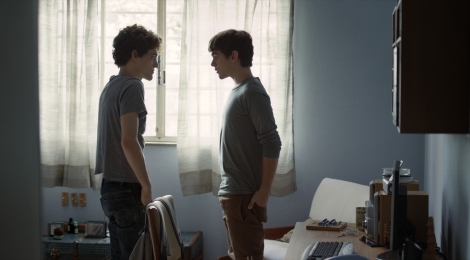
Small Festivals, Youth, and the Monterrey International Film Festival
This week Mediático is delighted to present a post by Juan Llamas Rodriguez, Graduate Student at the University of California Santa Barbara on the FIC Monterrey International Film Festival 26-31 August 2014.
Film festival studies has tended to focus primarily on large, world-renowned festivals, but a new set of scholarship is shifting attention to “small festivals” – those that, despite not having global influence or economic hegemony, gain their international importance from how they empower their local communities.1 Small festivals become notably relevant for communities that are dispersed, disenfranchised, or otherwise absent from major cinematic traditions. In order to understand the significance of small festivals, scholars need to be attuned to micro processes of production, distribution, and community formation that are distinct for the networks wherein they operate. Furthermore, attending to these smaller networks and how, in their way, they contribute to global film trends would undoubtedly benefit efforts to chart the heterogeneity of global Hispanic cinema.
In order to exemplify the importance of studying small festivals, I will consider the Monterrey International Film Festival (FIC Monterrey, for its name in Spanish) in Monterrey, Nuevo Leon, Mexico, which celebrated its tenth anniversary this past August. On an international level, the FIC Monterrey may still lack the prestige and name recognition of Guadalajara’s and Morelia’s events. Yet, along with the state’s cinematheque, Cineteca Nuevo Leon, the festival already plays an integral role in shaping and nurturing a film scene within the largest metropolitan area in northern Mexico. Its future success seems at least partially contingent on the festival finding an identity for itself and capitalizing on it. Festival director Juan Manuel Gonzalez hinted as much when he spoke about the importance of a festival identity during his opening remarks to the 2014 edition. Gonzalez emphasized that the FIC Monterrey was not tied down to a genre, a topic, or a niche, and, in his view, this lack of an explicit programming credo opened up the festival to all sorts of films and audiences. However, in this speech, and indeed in his remarks throughout the festival, Gonzalez reiterated the special emphasis on programming and events for young people as a distinguishing mark of the FIC Monterrey. Despite the festival’s unwillingness to claim an identity so far, I would hold that this focus on youth – on young audiences and especially on young filmmakers – is currently its most defining characteristic, and what could potentially differentiate them on the national film scene for decades to come.
The FIC Monterrey already serves as a springboard for young filmmakers and particularly for local talent. Unlike Mexico’s other big metropolises, Monterrey does not have a large-scale film school so most local filmmakers train in akin programs such as communications or visual arts. The festival therefore acts as a hub for and promoter of a cinematographic culture amongst up-and-coming creatives. For years, one of the festivals most famous programmes has been the showcase of in-state students’ films, Muestra Estatal de Cine Estudiantil (MECE). Students from any university in the state are eligible to submit to the showcase, and, if selected, their work – which consists mostly of short films – is featured in special screenings. During my visit this year, I witnessed the tremendous popularity of this showcase, whose screenings were often packed and almost always sold out despite being scheduled in the middle of the day. For its tenth edition, the FIC Monterrey allowed the student submissions into competition and inaugurated a special award for them, which consisted of certificates for the rental of film equipment.
In its promotion of the redesigned MECE, the festival emphasized the higher quality of the students’ work as a factor motivating this shift. The creation of a specialized category runs the risk of ghettoizing these films as much as it celebrates them, but if the results from this year’s edition are any indication, this will not be the case. For example, the short film Un Dia Como Tantos (Mauricio Gutierrez, 2013), an intimate portrait of a woman telling her private love story, was one of the two honorary mentions in the MECE competition. Yet, despite not winning the student showcase award, Un Dia Como Tantos won the award for Best Mexican Documentary Short, thus reinforcing the festival’s claim that students’ works were now at a similar level as more seasoned festival fare.
The development of the MECE competition also represents a continuation from previous festival initiatives aimed at forming and sponsoring creative talent. Notably, for instance, the past seven editions of the festival have included a one-day industry summit, where studios, private companies, and government agencies host presentations or roundtables that are attended mostly by students and young filmmakers. This year included sessions with a post-production studio, a crowdsourcing advertising company, and representatives from IMCINE (Mexico’s Cinematographic Institute) on new production and distribution funding initiatives. The festival, then, both exhibits young filmmakers’ current works and facilitates opportunities for future ones.
Less overtly but just as significantly, the festival’s youth-centered approach extends beyond filmmakers to audiences as well. Partly this results from its appeal to student filmmakers, as they constitute a large percentage of the festival’s audience. As well, the city of Monterrey itself skews towards a younger demographic because of its many universities and start-up outsourcing industries. It benefits the festival to capture this large percentage of the population so it has found ways of catering to this potential audience. For instance, this year’s promotional video titled “No Puedes Dejar de Ver” (You Can’t Stop Watching), which accompanied an image redesign for the festival’s tenth anniversary, features a cast of predominantly twenty-to-thirty year olds standing in as the purported festival audience.
It is a service to this audience that the festival remains committed to being international, particularly through its programming. Almost every year it will feature a “Guest Country” and spotlight recent films from that nation. As well, it will host the national or state-wide premieres of international features and shorts that have already received acclaim elsewhere. Notably, two international features in this year’s edition were the Spanish film Vivir Es Facil Con Los Ojos Cerrados (David Trueba, 2013), which won Best Film at this year’s Goya awards, and the Brazilian Hoje Eu Quero Voltar Sozinho (Daniel Ribeiro, 2014) (pictured above), which has been on the festival circuit this year and is now poised to represent Brazil at the Academy Awards for 2015.
 Upon first glance, Hoje Eu Quero Voltar Sozinho presents a standard teen love story albeit with a twist: the relationship between Leonardo, who is blind, and Giovana, his best friend whom he continuously relies on, is forever altered when an attractive new classmate, Gabriel, arrives and sparks an interest in Leonardo. However, the film grows from a teen love story into a more complex portrayal of youth living with disabilities when it focuses on the small moments in Leonardo’s life – his daily interactions with his parents or his grandmother, his struggles for self-reliance – that showcase a narrative rarely told in films about young people. Ghilherme Lobo plays Leonardo with a mix of determination and self-doubt that is a joy to watch, and director Daniel Ribeiro’s open framing and unobtrusive camerawork – along with the ornate art direction – build a sense of controlled space that visually echoes the character’s inner journey.
Upon first glance, Hoje Eu Quero Voltar Sozinho presents a standard teen love story albeit with a twist: the relationship between Leonardo, who is blind, and Giovana, his best friend whom he continuously relies on, is forever altered when an attractive new classmate, Gabriel, arrives and sparks an interest in Leonardo. However, the film grows from a teen love story into a more complex portrayal of youth living with disabilities when it focuses on the small moments in Leonardo’s life – his daily interactions with his parents or his grandmother, his struggles for self-reliance – that showcase a narrative rarely told in films about young people. Ghilherme Lobo plays Leonardo with a mix of determination and self-doubt that is a joy to watch, and director Daniel Ribeiro’s open framing and unobtrusive camerawork – along with the ornate art direction – build a sense of controlled space that visually echoes the character’s inner journey.
Vivir Es Facil Con Los Ojos Cerrados, written and directed by David Trueba, centers on three unlikely characters on a road trip to meet John Lennon as he shoots a film in Almeria, Spain. Javier Camara leads the cast with a heartfelt, nuanced performance as the eternal optimist Antonio, but young actors Natalia de Molina and Francesc Colomer also shine in their supporting performances. Yet the heart of the film rests on Trueba’s script, part comedy and part melodrama, and his balance of both elements. Although some moments reveal the darkness lurking in the characters’ daily lives – which is inevitable since Trueba sets his story against the backdrop of Francoist Spain, the pacing of the story and the carefully-timed moments of comedy keep a lighthearted tone throughout the film even as it delves into issues of family abuse or bullying. Trueba’s constant use of lush colors and sweeping vistas underlies this affective dimension of the film, and is what gives this period piece a fresh feel.
The variety of international fare that the festival showcases is perhaps why its director stresses the lack of a specific festival identity. Still, the regionalism intrinsic in FIC Monterrey, particularly in its support of young filmmakers, sets it apart from other festivals of its size. While the Guanajuato International Film Festival, for instance, also showcases student work and features industry-geared events for up-and-coming talents, these are open to filmmakers from all parts of the country. Whether FIC Monterrey’s special focus on films produced in northern Mexico and by filmmakers from the area is the result of limited resources or a proactive agenda remains unclear. Yet, in its current iteration, the narrow scope is notable for how it foments and commemorates a local film culture that, despite having a long history is often ignored in favor of the bigger, more cosmopolitan cultures of central Mexico.2
It should come as no surprise that FIC Monterrey has a potential identity in celebrating local young filmmakers and targeting young audiences since the arts and culture scene in Monterrey, and the state of Nuevo Leon more broadly, is still burgeoning. The statewide arts institution CONARTE is just under two decades old, and the state cinematheque, along with many other arts promoting venues, have only come about since the turn of the century.3 The festival, like the local cultural network to which it belongs, is defined by its youth. Yet, rather than taking this feature as an obstacle to overcome, I submit that it could become the cornerstone of its identity as a festival. Celebrating and fomenting a film culture for northern Mexico may come to define the festival nationally and internationally, and, in turn, enriching this local culture in the eyes of outsiders would cycle back to give the festival the recognition it continues to strive for.
- Saglier, Viviane. “Unstable and sustainable: the film festival institution and the case of the Franco-Arab Film Festival in the Occupied Palestinian Territories”. Transnational Cinemas 5.1 (2014): 41-56. ↩
- See De La Vega Alfaro, Eduardo. Microhistorias Del Cine En Mexico. Guadalajara: Universidad De Guadalajara, 200 and Serna, Laura Isabel. “Exhibition in Mexico During the Early 1920s”. Convergence Media History. Eds. Janet Staiger and Sabine Hake. New York: Routledge, 2009. 69-80. ↩
- Farias Campero, Carolina. “Las Artes Visuales”. Nuevo Leon de Cara al Siglo XII. Monterrey, NL: Fondo Editorial de Nuevo Leon, 2005. 85-116. ↩







